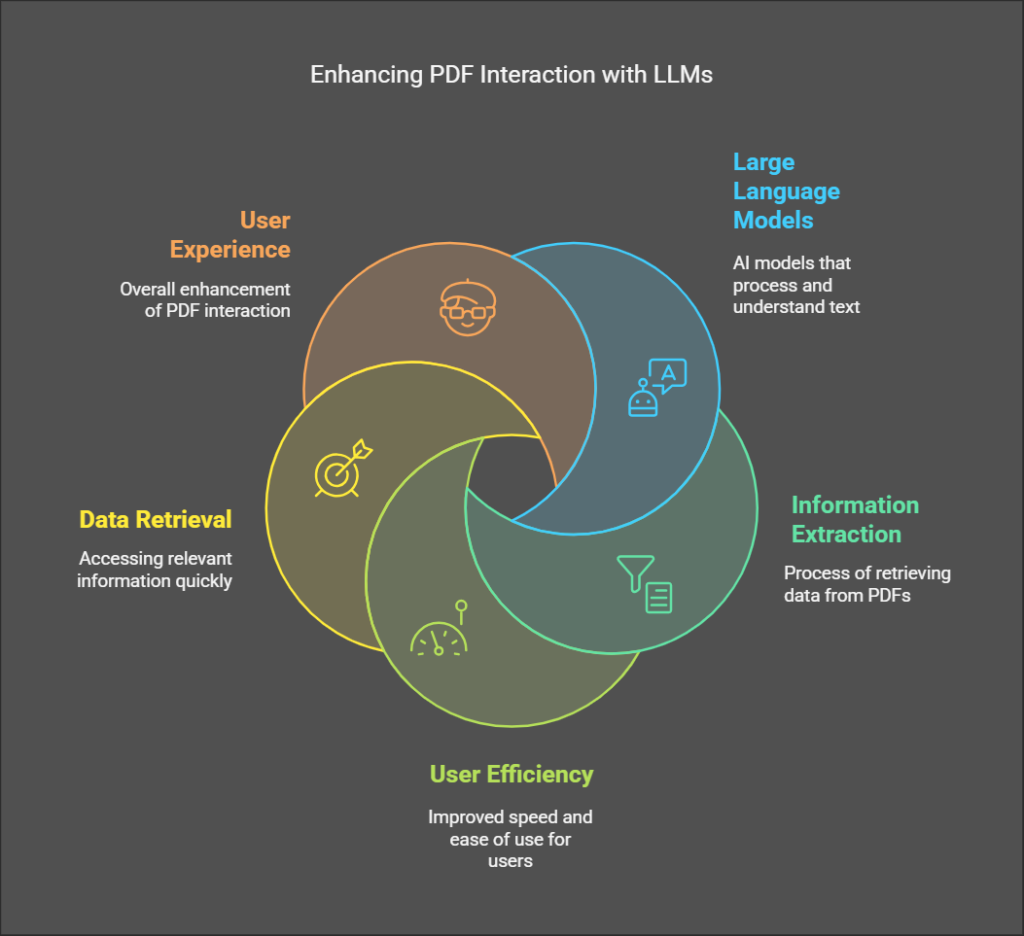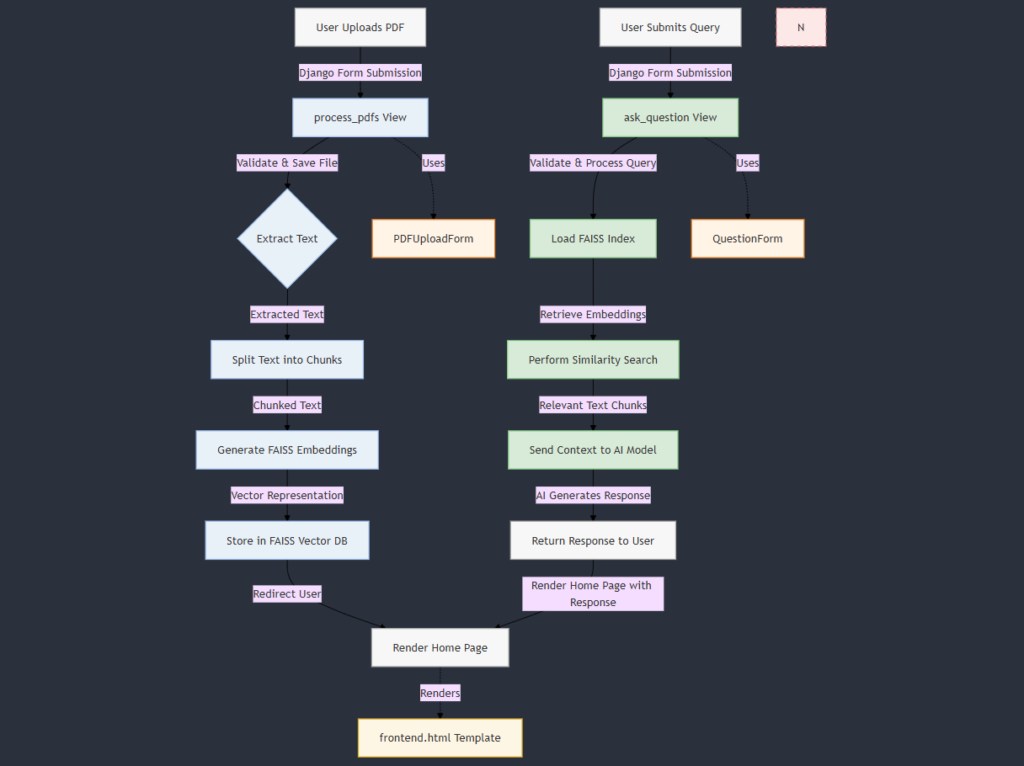
Introduction: The AI Revolution in Document Processing
The ability to interact with and extract information from documents has long been a challenge across industries. Whether it’s legal contracts, research papers, corporate reports, or policy guidelines, these documents contain critical insights that often remain buried within pages of text. Traditional methods of information retrieval—manual searches, keyword lookups, and indexing—are inefficient, time-consuming, and prone to human error. But with the rise of Artificial Intelligence and Generative AI, a new wave of document analysis is emerging.
During my internship at Valentius Kryptix, I worked on an AI-powered PDF Query Tool that integrates Natural Language Processing (NLP), Vector Search, and Generative AI to enable context-aware document querying. Instead of painstakingly searching for information manually, users can now simply ask a question and receive precise, AI-generated responses based on the content of the document. This breakthrough represents a shift from static document search to interactive AI-driven knowledge retrieval, where AI not only retrieves text but understands, synthesizes, and presents meaningful insights.
The Challenges of Traditional Document Search
For decades, document search has relied on rule-based keyword matching. While this approach helps locate specific words or phrases, it fails to understand the context in which those words are used. A contract might mention “liabilities” multiple times, but understanding the actual legal obligations requires deeper semantic comprehension—something keyword search alone cannot achieve.
In research and legal fields, professionals often need to sift through extensive documents to extract specific insights. Traditional search tools fail when users:
- Do not know the exact wording of the information they need.
- Need context-based answers that require reasoning across multiple sections of a document.
- Require summarized insights rather than raw text excerpts.
This is where Generative AI-powered search comes into play. Unlike traditional systems, which retrieve text based on word matches, AI models understand the intent behind queries, extract relevant information, and generate human-like responses in a conversational manner.
How Generative AI is Transforming Document Analysis
At the core of this project is Generative AI, which enables interactive, natural language-based document querying. Instead of relying on predefined search parameters, users can pose questions in plain English, and the AI will retrieve, analyze, and generate responses tailored to the document’s content.

Key Innovations in AI-Driven Document Understanding
🔹 Semantic Search & Contextual Retrieval
Traditional search retrieves exact matches, but Generative AI leverages embeddings and vector search to map queries to relevant concepts rather than just words. This means a query like:
“What are the financial penalties in this contract?”
will return the exact legal clauses discussing penalties, even if the document does not use the word “penalty” explicitly.
🔹 Conversational AI for Interactive Querying
Unlike static search, Generative AI provides a dynamic, conversational interface. Users can ask follow-up questions, refine their search results, and receive AI-generated explanations. This makes information retrieval more intuitive and user-friendly.
🔹 Summarization & Insight Extraction
Long documents often contain information spread across multiple sections. Instead of requiring users to manually scan for answers, AI can summarize content in real-time. For instance, users can request:
“Summarize the main points of this report in 5 bullet points.”
The AI will synthesize key takeaways and present them concisely.
🔹 Multi-Step Reasoning for Complex Queries
Generative AI can connect multiple pieces of information across different document sections. If a research paper discusses methodologies in one section and results in another, the AI can retrieve both, analyze the data, and provide a comprehensive answer.
How It Works: AI-Powered Document Querying in Action
To achieve this level of intelligent search and response generation, the system integrates multiple AI and NLP components:

✅ Google Gemini AI – For advanced natural language understanding and text generation.
✅ FAISS (Facebook AI Similarity Search) – To enable efficient vector-based document retrieval.
✅ PyPDF2 – To extract text from PDFs and preprocess content.
✅ LangChain – For structuring, chunking, and embedding text dynamically.
✅ Django & Python – To build an interactive, web-based user interface.

Challenges in Implementing AI-Powered Document Search
Building an AI-driven document assistant is not just about integrating an LLM—it involves tackling various technical challenges:
✔ Handling Large Documents Efficiently
Breaking down long PDFs into context-aware chunks without losing meaning was essential. Optimizing chunk sizes helped improve retrieval accuracy.
✔ Balancing Speed & Accuracy
Generating AI responses in real-time required optimizing vector search, embedding retrieval, and response generation to minimize latency.
✔ Ensuring Contextual Precision
AI models sometimes produce hallucinated responses. To prevent misinformation, the system was designed to strictly rely on retrieved document content before generating an answer.
The Future of AI-Driven Document Interaction
This project is just the beginning. With ongoing advancements in Generative AI and NLP, document analysis is evolving toward:
🔹 AI-powered legal assistants that can draft contracts and highlight risks in legal documents.
🔹 Research assistants that can summarize, compare, and analyze findings across multiple papers.
🔹 Automated corporate document analysis for financial reports, policy briefs, and compliance checks.
🔹 Voice-enabled AI search, allowing users to ask queries verbally and receive spoken responses.
Conclusion: The Next Frontier in AI-Powered Information Retrieval
The development of this AI-powered PDF Query Tool represents a fundamental shift in how we interact with and extract knowledge from documents. By leveraging Generative AI, NLP, and vector search, it transforms static text into dynamic, intelligent, and interactive knowledge systems. This project has been a transformative learning experience, deepening my understanding of how AI can automate and enhance real-world problem-solving.
With AI continuing to evolve, the future of document analysis is moving beyond simple search functions to fully interactive AI-driven research assistants. The days of manually scanning through hundreds of pages are numbered—AI is here to revolutionize information retrieval.
#ArtificialIntelligence #GenerativeAI #MachineLearning #NLP #GoogleGemini #Django #FAISS #LangChain #AIForGood #ICARNBSSLUP #Innovation #AIRevolution




Leave a Reply